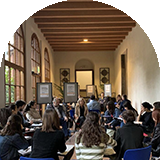1. Study the international universities’ educational offer:
First study the sites of the international universities to be clear on the courses that are offered and whether they are compatible with your study plan. The fact that a destination is among the partners of your faculty is already a good start because it implies that there is compatibility of the courses offered, but remember that each programme abroad is a separate pathway.
Tips:
- The 3+2-year pattern of study is not universal: it is better to use the following as your point of reference: Undergraduate or Bachelor - Graduate or Master of Arts or Science
- International and Italian credits may not be an exact match. A US examination of 4 credits may be recognised as an examination of 8 credits in Cattolica
- Check course schedules and the number of lesson hours: credits may not be equivalent, so it is important instead that the number of frontal lesson hours is similar to the number of lesson hours you would take in Cattolica
- It is not mandatory that all exams coincide perfectly
2. Think about equivalence with your Cattolica study plan
"Professor, I would like to study in Australia. What course can I take to get recognition in Statistics?" This question is too general to answer. How would you be able to answer an American student who said, "I want to come and study in Italy and do an Archaeology exam that can be recognised by my university. What course can I take?"
Think hard about how the international exam might correspond to an exam in your Cattolica study plan.
Examples: Corporate Finance = Corporate Finance; The Economics of Accounting Decisions = Corporate quantitative methodologies and determinations.
Tips:
- Think about as many possibilities as possible
- Semesters do not have to coincide perfectly. You can take an exam abroad in the first semester that you would normally have taken in Cattolica in the second semester, and vice versa.
- You can also recoup exams or take exams you would normally have taken in the future.
- You can combine semester exams for an annual exam or take supplementary exams when you return (this option is not possible for all faculties)
3. Submit exam approval application to the Cattolica professor responsible for credit approval in line with faculty procedure (Programme Plan or approval forms)
Once feasible equivalence has been identified, follow faculty instructions for submission to professors.
Read details here.
Tips:
- Each faculty/campus has its own rules, so do not just rely on the word of friends and acquaintances. Always refer to Cattolica International
- Ask for approval for as many exams as possible
- Keep approval documentation: it is definitive!
- Refer to past approved exams record - see link (bottom of the page)
4. Check any conditions/prerequisites/requirements put in place by the university abroad
The fact that you have obtained approval for Cattolica exams does not guarantee admission abroad: you also need to check any specific conditions imposed by the international university.
Tips:
- There may be a fixed minimum or maximum number of exams you can take
- Prerequisites may apply in order to ensure consistency among students from different academic backgrounds







